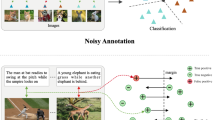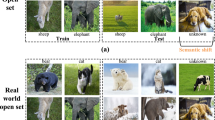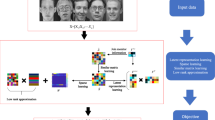Abstract
Most existing approaches for person re-identification are designed in a supervised way, undergoing a prohibitively high labeling cost and poor scalability. Besides establishing effective similarity distance metrics, these supervised methods usually focus on constructing discriminative and robust features, which is extremely difficult due to the significant viewpoint variations. To overcome these challenges, we propose a novel unsupervised method, termed as Robust Dictionary Learning with Graph Regularization (RDLGR), which can guarantee view-invariance through learning a dictionary shared by all the camera views. To avoid the significant degradation of performance caused by outliers, we employ a capped l 2,1-norm based loss to make our model more robust, addressing the problem that traditional quadratic loss is known to be easily dominated by outliers. Considering the lack of labeled cross-view discriminative information in our unsupervised method, we further introduce a cross-view graph Laplacian regularization term into the framework of dictionary learning. As a result, the geographical structure of original data space can be preserved in the learned latent subspace as discriminative information, making it possible to further boost the matching accuracy. Extensive experimental results over four widely used benchmark datasets demonstrate the superiority of the proposed model over the state-of-the-art methods.









Similar content being viewed by others
References
An L, Chen X, Yang S, Bhanu B (2016) Sparse representation matching for person re-identification. Inf Sci 355:74–89
Bird ND, Masoud O, Papanikolopoulos NP, Isaacs A (2005) Detection of loitering individuals in public transportation areas. IEEE Trans Intell Trans Syst 6(2):167–177
Cai D, He X, Han J, Huang TS (2011) Graph regularized nonnegative matrix factorization for data representation. IEEE Trans Pattern Anal Mach Intell 33(8):1548–1560
Chang X, Nie F, Yang Y, Zhang C, Huang H (2016) Convex sparse pca for unsupervised feature learning. ACM Trans Knowl Discov Data 11(1):3
Chang X, Yang Y (2016) Semisupervised feature analysis by mining correlations among multiple tasks. IEEE Trans Neural Netw Learn Syst. https://doi.org/10.1109/TNNLS.2016.2582746
Chang X, Yu YL, Yang Y, Xing EP (2016) Semantic pooling for complex event analysis in untrimmed videos. IEEE Trans Pattern Anal Mach Intell 39(8):1617–1632
Chen D, Yuan Z, Chen B, Zheng N (2016) Similarity learning with spatial constraints for person re-identification. In: CVPR
Cheng DS, Cristani M, Stoppa M, Bazzani L, Murino V (2011) Custom pictorial structures for re-identification. In: BMVC
Cheng D, Gong Y, Zhou S, Wang J, Zheng N (2016) Person re-identification by multi-channel parts-based cnn with improved triplet loss function. In: CVPR
Davis JV, Kulis B, Jain P, Sra S, Dhillon IS (2007) Information-theoretic metric learning. In: ICML
Dikmen M, Akbas E, Huang TS, Ahuja N (2010) Pedestrian recognition with a learned metric. In: ACCV
Farenzena M, Bazzani L, Perina A, Murino V, Cristani M (2010) Person re-identification by symmetry-driven accumulation of local features. In: CVPR
Gheissari N, Sebastian TB, Hartley R (2006) Person reidentification using spatiotemporal appearance. In: CVPR
Gong S, Cristani M, Yan S, Loy CC (2014) Person re-identification, vol 1. Springer
Gray D, Brennan S, Tao H (2007) Evaluating appearance models for recognition, reacquisition, and tracking. In: PETS
Guo X (2015) Robust subspace segmentation by simultaneously learning data representations and their affinity matrix. In: IJCAI
Harandi M, Sanderson C, Shen C, Lovell BC (2013) Dictionary learning and sparse coding on grassmann manifolds: an extrinsic solution. In: ICCV
Hirzer M, Beleznai C, Roth PM, Bischof H (2011) Person re-identification by descriptive and discriminative classification. In: SCIA
Hirzer M, Roth PM, Bischof H (2012) Person re-identification by efficient impostor-based metric learning. In: AVSS
Jing XY, Zhu X, Wu F, You X, Liu Q, Yue D, Hu R, Xu B (2015) Super-resolution person re-identification with semi-coupled low-rank discriminant dictionary learning. In: CVPR
Karanam S, Li Y, Radke RJ (2015) Person re-identification with discriminatively trained viewpoint invariant dictionaries. In: ICCV
Kodirov E, Xiang T, Gong S (2015) Dictionary learning with iterative laplacian regularisation for unsupervised person re-identification. In: BMVC
Koestinger M, Hirzer M, Wohlhart P, Roth PM, Bischof H (2012) Large scale metric learning from equivalence constraints. In: CVPR
Li S, Yin H, Fang L (2012) Group-sparse representation with dictionary learning for medical image denoising and fusion. IEEE Trans Biomed Eng 59(12):3450–3459
Li Z, Chang S, Liang F, Huang TS, Cao L, Smith JR (2013) Learning locally-adaptive decision functions for person verification. In: CVPR
Li W, Zhao R, Xiao T, Wang X (2014) Deepreid: deep filter pairing neural network for person re-identification. In: CVPR
Li S, Shao M, Fu Y (2015) Cross-view projective dictionary learning for person re-identification. In: IJCAI
Lisanti G, Masi I, Del Bimbo A (2014) Matching people across camera views using kernel canonical correlation analysis. In: ICDSC
Lisanti G, Masi I, Bagdanov AD, Del Bimbo A (2015) Person re-identification by iterative re-weighted sparse ranking. IEEE Trans Pattern Anal Mach Intell 37(8):1629–1642
Liu BD, Wang YX, Zhang YJ, Shen B (2013) Learning dictionary on manifolds for image classification. Pattern Recogn 46(7):1879–1890
Liu X, Song M, Tao D, Zhou X, Chen C, Bu J (2014) Semi-supervised coupled dictionary learning for person re-identification. In: CVPR
Ma B, Su Y, Jurie F (2012) Bicov: a novel image representation for person re-identification and face verification. In: BMVC
Mairal J, Bach F, Ponce J, Sapiro G (2009) Online dictionary learning for sparse coding. In: ICML
Matsukawa T, Okabe T, Sato Y (2014) Person re-identification via discriminative accumulation of local features. In: ICPR
Mignon A, Jurie F (2012) Pcca: a new approach for distance learning from sparse pairwise constraints. In: CVPR
Nie F, Yuan J, Huang H (2014) Optimal mean robust principal component analysis. In: ICML
Nie L, Zhang L, Wang M, Hong R, Farseev A, Chua TS (2017) Learning user attributes via mobile social multimedia analytics. ACM Trans Intell Syst Technol 8(3):36
Pedagadi S, Orwell J, Velastin S, Boghossian B (2013) Local fisher discriminant analysis for pedestrian re-identification. In: CVPR
Peng P, Xiang T, Wang Y, Pontil M, Gong S, Huang T, Tian Y (2016) Unsupervised cross-dataset transfer learning for person re-identification. In: CVPR
Qi M, Han J, Jiang J, Liu H (2017) Deep feature representation and multiple metric ensembles for person re-identification in security surveillance system. Multimed Tools Appl. https://doi.org/10.1007/s11042-017-4649-2
Skretting K, Engan K (2010) Recursive least squares dictionary learning algorithm. IEEE Trans Signal Process 58(4):2121–2130
Song X, Nie L, Zhang L, Liu M, Chua TS (2015) Interest inference via structure-constrained multi-source multi-task learning. In: IJCAI
Varior RR, Wang G, Lu J, Liu T (2016) Learning invariant color features for person reidentification. IEEE Trans Image Process 25(7):3395–3410
Wang H, Gong S (2014) Xiang. Unsupervised learning of generative topic saliency for person re-identification, T.
Wang Z, Hu R, Liang C, Yu Y, Jiang J, Ye M, Chen J, Leng Q (2016) Zero-shot person re-identification via cross-view consistency. IEEE Trans Multimedia 18(2):260–272
Weinberger KQ, Saul LK (2009) Distance metric learning for large margin nearest neighbor classification. J Mach Learn Res 10:207–244
Xiao T, Li H, Ouyang W, Wang X (2016) Learning deep feature representations with domain guided dropout for person re-identification. In: CVPR
Xiong F, Gou M, Camps O, Sznaier M (2014) Person re-identification using kernel-based metric learning methods. In: ECCV
Xu Y, Guo J, Huang Z, Qiu W (2017) Sparse coding with cross-view invariant dictionaries for person re-identification. Multimed Tools Appl. https://doi.org/10.1007/s11042-017-4893-5
Yang Y, Wen L, Lyu S, Li SZ (2017) Unsupervised learning of multi-level descriptors for person re-identification. In: AAAI
Yu K, Zhang T, Gong Y (2009) Nonlinear learning using local coordinate coding. In: NIPS
Zhang T (2009) Multi-stage convex relaxation for learning with sparse regularization. In: NIPS
Zhang Q, Li B (2010) Discriminative k-svd for dictionary learning in face recognition. In: CVPR
Zhao R, Ouyang W, Wang X (2013) Person re-identification by salience matching. In: ICCV
Zhao R, Ouyang W, Wang X (2013) Unsupervised salience learning for person re-identification. In: CVPR
Zhao R, Ouyang W, Wang X (2014) Learning mid-level filters for person re-identification. In: CVPR
Zheng WS, Gong S, Xiang T (2009) Associating groups of people. In: BMVC
Zheng M, Bu J, Chen C, Wang C, Zhang L, Qiu G, Cai D (2011) Graph regularized sparse coding for image representation. IEEE Trans Image Process 20(5):1327–1336
Zheng WS, Gong S, Xiang T (2011) Person re-identification by probabilistic relative distance comparison. In: CVPR
Zheng WS, Gong S, Xiang T (2013) Reidentification by relative distance comparison. IEEE Trans Pattern Anal Mach Intell 35(3):653–668
Acknowledgments
This work was funded by the National Science Foundation of China (Nos. 61502377, 61532004), the National Key Research and Development Program of China (No. 2016YFB1000903); Ministry of Education Innovation Research Team (No. IRT_17R86); Project of China Knowledge Center for Engineering Science and Technology, and China Postdoctoral Science Foundation (No. 2015M582662).
Author information
Authors and Affiliations
Corresponding author
Rights and permissions
About this article
Cite this article
Yan, C., Luo, M., Liu, W. et al. Robust dictionary learning with graph regularization for unsupervised person re-identification. Multimed Tools Appl 77, 3553–3577 (2018). https://doi.org/10.1007/s11042-017-5202-z
Received:
Revised:
Accepted:
Published:
Issue Date:
DOI: https://doi.org/10.1007/s11042-017-5202-z




